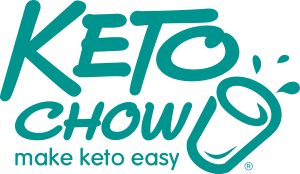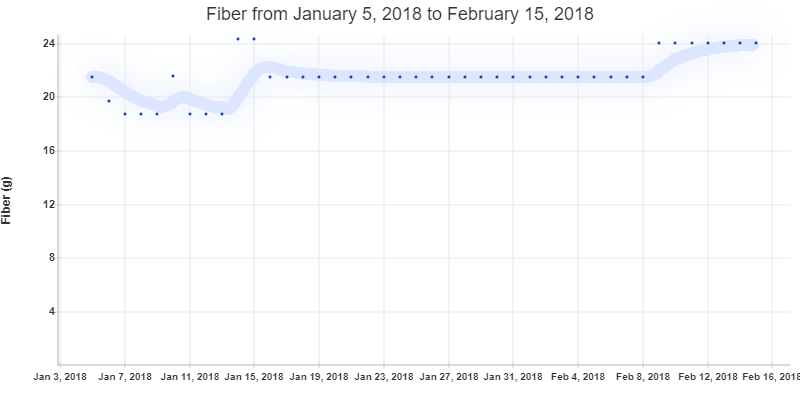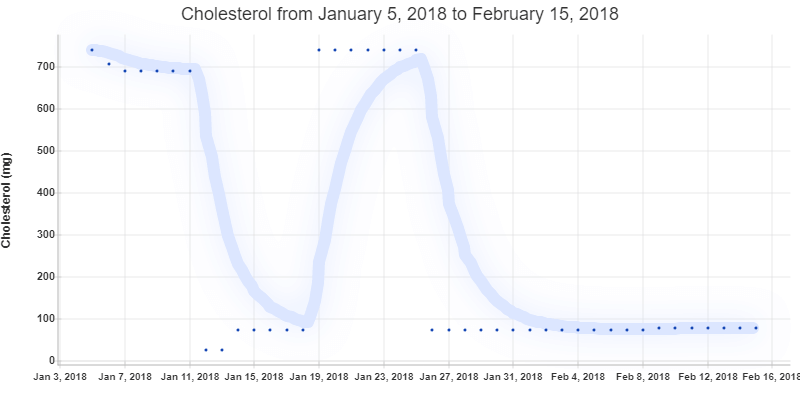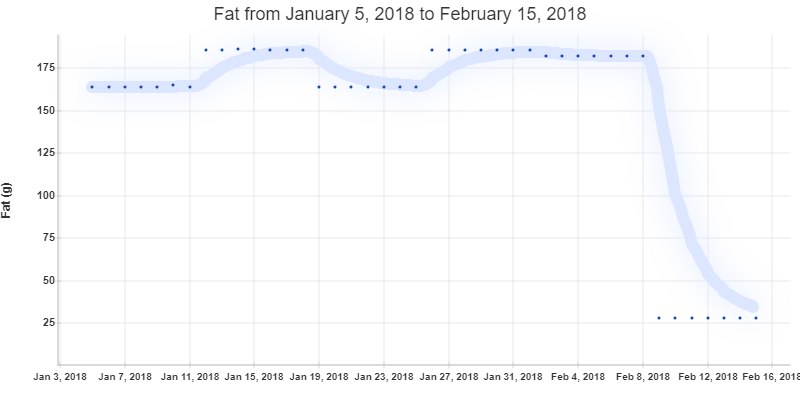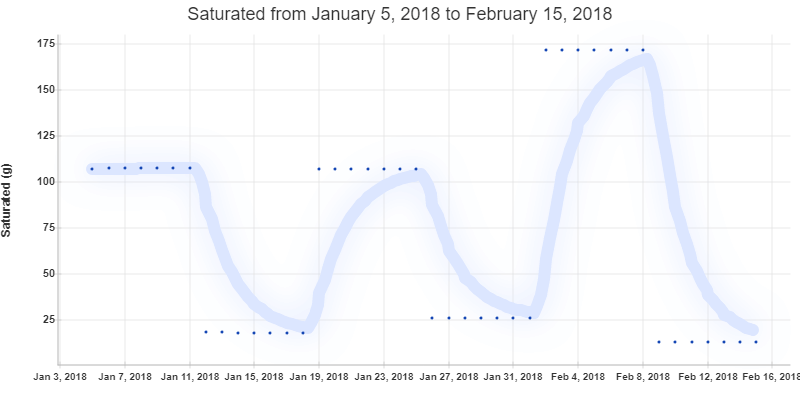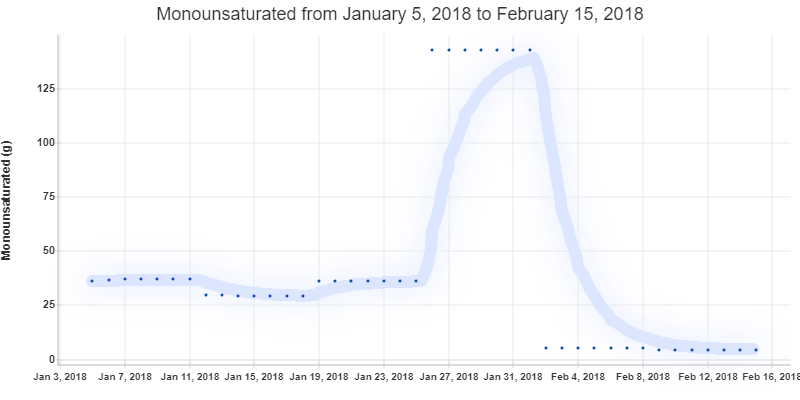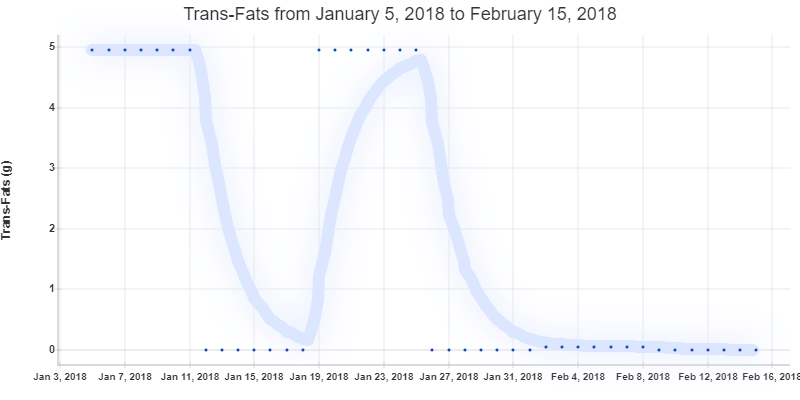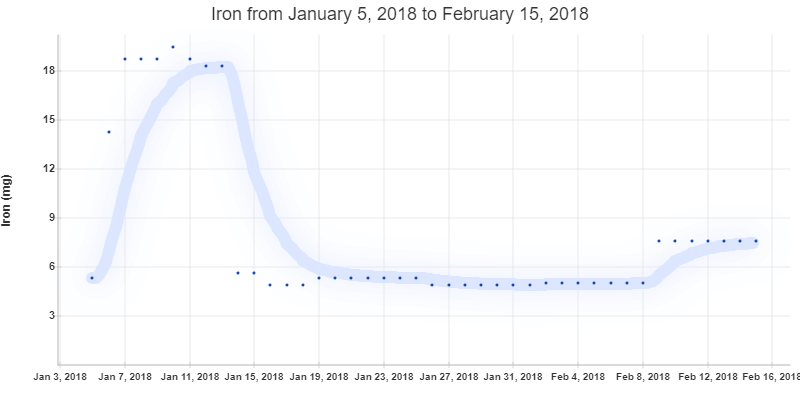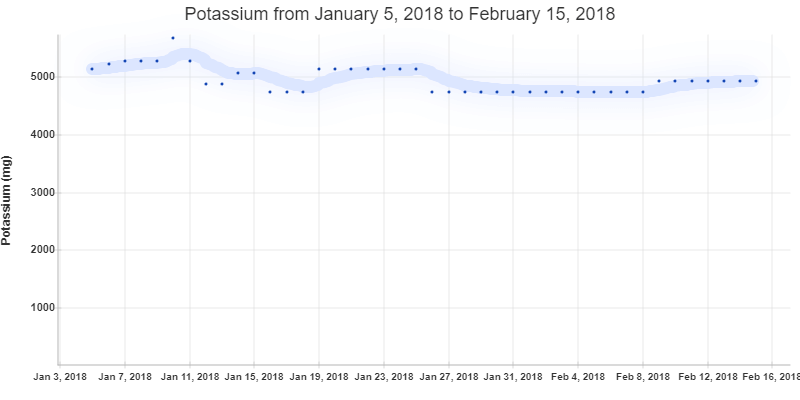Abstract
My previous experiment where all of my calories for 4 weeks came via Keto Chow brought out some interesting data in my 3rd week. That week I changed my fat source from heavy cream over to avocado oil, this resulted in some remarkable blood tests. A question arises as to whether my elevated Triglycerides, lowered LDL, Lowered HDL, and more are a result of the reduced carbohydrates (under 2g net a day average), or the composition of the fats I was eating: Saturated vs. Monounsaturated, vs. Polyunsaturated. This experiment intends to answer that question by isolating the fatty acids as the only variable.
At the same time, I put another popular theory to the test: CICO or “Calories In = Calories Out”. The theory is that a calorie, is a calorie, is a calorie; and that the kind of calories makes no difference, only the quantity of calories. People get overweight because they eat more calories than they burn, which is the same as saying people get wealthy because they spend less money than they earn – both are technically true but don’t tell you the why, just the what. Even die-hard CICO believers will balk at giving kids cookies for dinner (which is funny, I thought a calorie was a calorie!). Regardless, I was able to definitively isolate the number of calories as a fixed variable with the only change being the type of calories: either from different kinds of fats, or from different forms of glucose and fructose. If the type of food is irrelevant, I should have seen no change in weight loss, blood sugar, energy, or other results. My hypothesis was that during the week I’m replaced fat with carbohydrates I would:
- Gain weight, initially from glycogen (water weight) but it will likely go beyond that.
- Feel like crap with little energy, despite an overabundance of glucose in my system.
- My fasting insulin would go through the roof.
- My A1c would go up.
- My Blood sugar will also go way up.
Experiment Methodology
Each week I will be testing a different fat/calorie source. Each will be tuned for 2000 calories a day total caloric intake.
- Week 0: Heavy cream for my “wash-out” period
- Week 1: Oil high in PUFAs (Grape Seed Oil)
- Week 2: Heavy Cream – high in Saturated Fatty Acids but does not contain Medium Chain Triglycerides which could confound the results.
- Week 3: Oil high in MUFAs (Macadamia Nut Oil)
- Week 4: Oil High in Saturated Fatty Acids (Liquid Coconut Oil – this is also high in Medium Chain Triglycerides which are metabolized directly into ketones)
- Week 5: Carbohydrates – via dextrose, soda, and candy
I will be taking fish pills all 6 weeks, including week 5 where I will be only consuming 28g of fats a day. This will be the embodiment of conventional recommendations of high carb low fat. I expect to feel like crap and to gain weight using the same calorie amount as the previous weeks.
Test Plan:
- After week 0, I had blood tests taken, these were repeated every week (Friday) at the end of that 7 day period.
- At the beginning of week 5 (carbs) I would do a test to measure the effect of drinking Keto Chow with dextrose and candy on my postprandial glucose so I could compare this result to an earlier test of just drinking Keto Chow with heavy cream.
- Every day I would test my blood ketones – I used a “KetoMojo” blood tester for this due to the lower cost per ketone test. I would also check my blood glucose during week 5 (carbs)
- My weight would be tracked using a Withings (Nokia) scale.
- There were a total of 3 DEXA scans: before week 0, before week 5, and after week 5
[visualizer id=”23810″]
[visualizer id=”23808″]
[visualizer id=”23814″]
[visualizer id=”24583″]
[visualizer id=”23815″]
[visualizer id=”23803″]
Food Logs and Nutrient Analytics
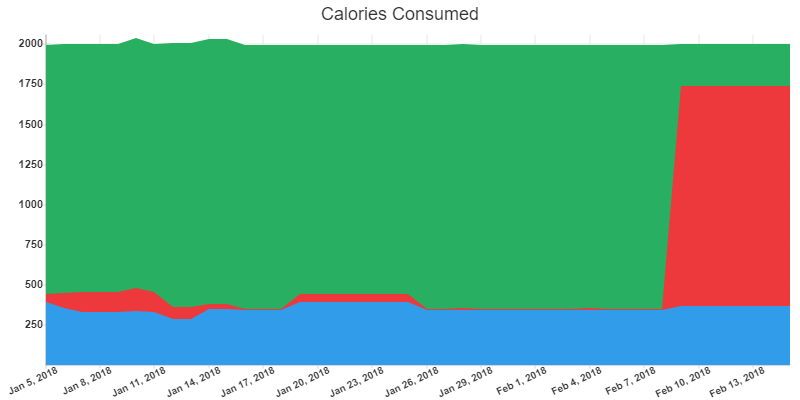
One of the main criticisms of Morgan Spurlock’s “Supersize Me” is that he absolutely refuses to release his food logs. You can’t take an experiment, even an N=1 experiment, seriously unless you can look at the data. Here are my own food logs for the entire experiment. The data was collected using Cron-O-Meter.
- Cronometer Full Nutrition Report (includes daily food logs and analysis)
- CSV export of all food eaten during the test period with nutrient information for each
Test Results (Blood and others)
I did 6 blood tests during the experiment. The easiest way to look at the results is by reading this spreadsheet. Here are some of the graphs from the spreadsheet.
Note that the spreadsheet and the graphs have data from all of the experiments I’ve done thus far.
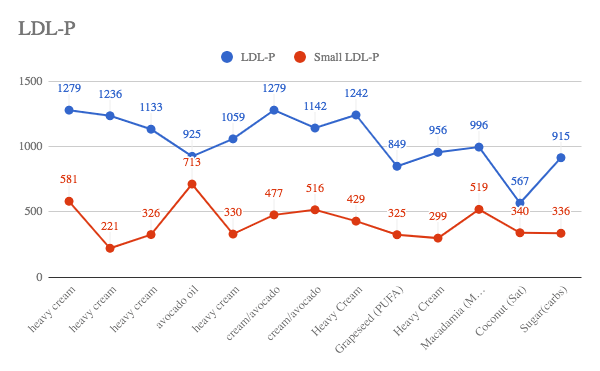
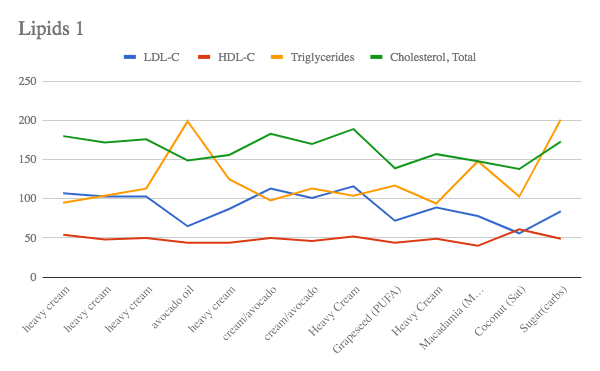
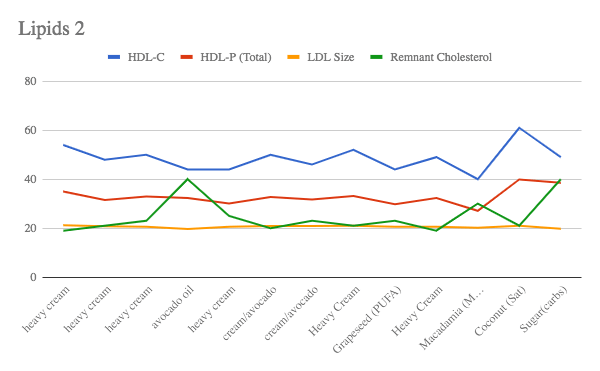
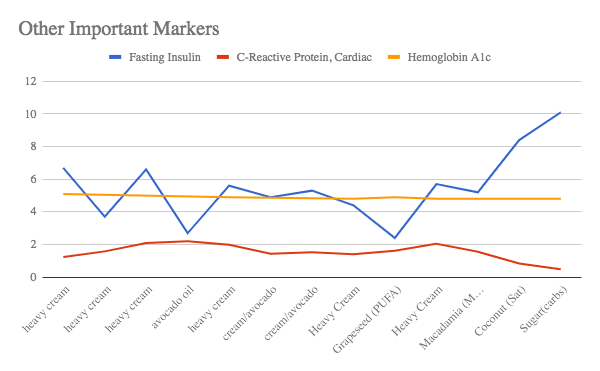
- Blood Test 2018-01-12 Week 0 – Heavy Cream (Saturated, no MCTs)
- Blood Test 2018-01-19 Week 1 – Grape Seed Oil (PUFAs)
- Blood Test 2018-01-26 Week 2 – Heavy Cream (Saturated, no MCTs)
- Blood Test 2018-02-02 Week 3 – Macadamia Nut Oil (MUFAs)
- Blood Test 2018-02-09 Week 4 – Coconut Oil (Saturated, High MCTs)
- Blood Test 2018-02-16 Week 5 – Dextrose, Soda, Candy (High carbohydrate, low fat)
DEXA Scans
Blood Ketones throughout the experiment:
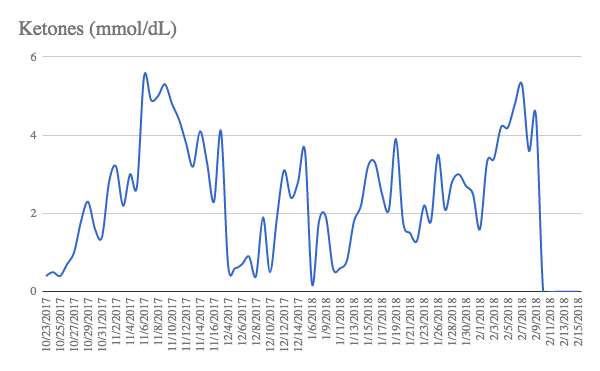
At the beginning of week 5, I ran a test of the effects of Keto Chow with dextrose and candy on my blood glucose levels after eating (and for several hours after). You can see those test results here. The short version of results: eating Keto Chow with sugar had a significant impact on my blood sugar, while an earlier test where I had Keto Chow with heavy cream had very little effect.
Keto Chow with Heavy Cream (two meals)
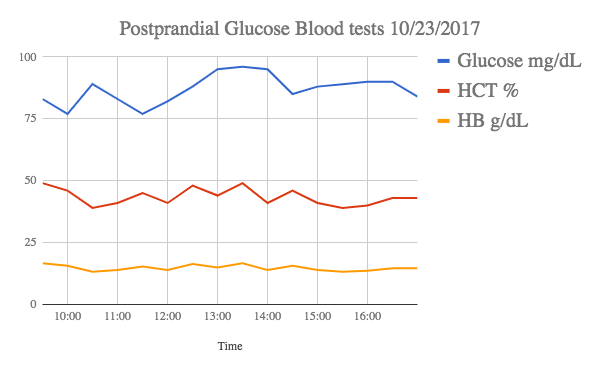
Keto Chow with Dextrose, Sprite, and Skittles (two meals)
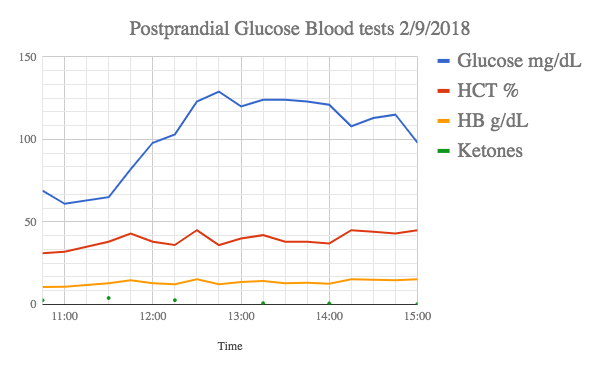
Experience
The daily video log updates (and accompanying text summaries)
- 42 Days of Keto Chow – Day 08 – Beginning Grape Seed Oil and a dissertation on PUFAs
- 42 Days of Keto Chow – Day 09
- 42 days of Keto Chow – Day 10
- 42 Days of Keto Chow – Day 11: soaring ketones, thoughts on exogenous ketones
- 42 Days of Keto Chow – Day 12, how I got started on nutritionally complete foods
- 42 Day of Keto Chow – Day 13: week 1 blood tests
- 42 Days of Keto Chow – Day 14
- 42 Days of Keto Chow – Day 15, back to heavy cream, self employed, history of Keto Chow shipping
- 42 Days of Keto Chow – Day 16, shoveling snow
- 42 Days of Keto Chow – Day 17
- 42 Days of Keto Chow – Day 18
- 42 Days of Keto Chow – Day 19
- 42 Days of Keto Chow – Day 20, off to S.F., Grape Seed Oil results
- 42 Days of Keto Chow – Day 21, Running on (almost) empty
- 42 Days of Keto Chow – Day 29, starting coconut oil!
- 42 Days of Keto Chow – Day 30, “fun” with coconut oil (actually MCT oil)
- 42 Days of Keto Chow – Day 31
- 42 Days of Keto Chow – Day 32, Superb Owl done
- 42 Days of Keto Chow – Day 33 – finalized plans for “carb week”
- 42 Days of Keto Chow – Day 34: on the ByteSized Podcast
- 42 Days of Keto Chow – Day 35, last day of coconut oil, macadamia nut oil results back
- 42 Days of Keto Chow – Day 36: Carb Week Begins (with a live stream)
- 42 Days of Keto Chow – Day 37 – full day on carbs done
- 42 Days of Keto Chow – Day 38, my mouth hurts
- 42 Days of Keto Chow – Day 39, new flavors
- 42 Days of Keto Chow – Day 40!
- 42 Days of Keto Chow – Day 41, blood tests back
- 42 Days of Keto Chow – Day 42, done done done.
Results and Conclusion
Saturated Fat as Heavy Whipping Cream
Heavy whipping cream served as a sort of “baseline” or control and was used twice in the experiment, for the Week 0 “washout” and in Week 2 after the PUFAs. Most of my analysis is based on comparing the other results to HWC.
Saturated fat has been considered “bad” for health since Ancel Keys falsified data in his “Seven Countries” study in 1953. A myriad of Senate committees, USDA policies, and other recommendations have followed – giving us the current common belief that saturated fat will “clog arteries” even though fats can’t traffic through your blood unless they are encased in a lipoprotein.
Despite all that, my blood tests on HWC look quite good; with triglycerides typically near or below 100, relatively normal HDL numbers, and LDL numbers that are irrelevant to all-cause mortality but rather normal as well. =) Given the amount of saturated fat I typically consume via HWC, most diet experts would assume I would be dead already.
Polyunsaturated Fat as Grape Seed Oil
Polyunsaturated fats are highly reactive with multiple double bonds in their molecular structure. They readily oxidize and were simply impossible to manufacture before advances in processing slowed rancidity sufficiently for them last long enough to be sold. Coming into the experiment, I expected PUFAs to increase inflammation and also lower my LDL. The lowering of LDL-C is the primary reason you’ll see “Heart Healthy” seed oils recommended by the American Heart Association and other “health” organizations. The ironic thing about PUFAs is many experts now believe that you may have a lower number of LDL particles because they become damaged by the free radicals associated with PUFA consumption and are removed from circulation by scavengers!
- LDL-Particles (hereafter “LDL-P”) – reduced significantly from 1242 to 849. Small LDL-P (LDL particles that have depleted their payload) also went down slightly
- LDL-Cholesterol (hereafter “LDL-C”) – was indeed reduced as well, from 116 to 72.
- Total Cholesterol went down considerably from 189 to 139. Triglycerides were raised from 104 to 117.
- HDL-P and HDL-C were reduced as well, which is universally considered a very bad result.
- It may be psychosomatic (I expected it to happen and it did) – my plantar fasciitis in my right foot started to return. I hadn’t experienced an issue with it since starting a ketogenic diet over 3 years prior.
In summary: Polyunsaturated fats do indeed appear to lower total cholesterol and LDL in particular. They also lower HDL (which is bad), raise triglycerides (also bad), and increase oxidative stress and inflammation (really bad).
Monounsaturated Fat as Macadamia Nut Oil
Monounsaturated fats are far more stable with a single double-bond in their molecular structure. They do not oxidize as easily (which we recognize as going rancid) which is why oils high in monounsaturated fats (such as olive oil) have been used for thousands of years. I chose Macadamia Nut oil because it has a higher percentage of MUFAs than olive or avocado oils.
- LDL-P increased compared to HWC, LDL-C decreased. Small LDL-P increased significantly from 299 to 519
- HDL-P and HDL-C both came to an all-time low at 27.1 and 40, respectively.
- The big news is that my triglycerides spiked: going from 94 to 148 – not nearly as distinctive as the spike while on avocado oil but definitive enough to safely conclude that the dramatic increase in my triglycerides during the earlier experiment was due to the MUFAs and NOT the PUFAs in the avocado oil.
MUFAs caused an increase in LDL and a decrease in HDL with a major increase in triglycerides.
Saturated Fat and Medium Chain Triglycerides as Liquid Coconut Oil
I wanted to use liquid coconut oil due to its high concentration of medium length fatty acids (MCTs). MCTs are metabolized differently compared to longer chain fats and will cause the production of ketones even in individuals eating higher amounts of carbohydrates than typical in a well-formulated ketogenic diet. MCTs also act as a confounder by skewing lipid profile results, so I was anxious to see how it would compare against the longer saturated fats in HWC. Initially, I used an LCO that was 93% MCT but that came with severe gastrointestinal problems and I switched to a different brand with approximately 50% MCTs. It’s generally recommended to not exceed 45ml of MCTs a day and I was doing 180ml initially with around 80ml thereafter.
- Until this point, there was a distinctive inversion pattern of LDL-C and Triglycerides. One would go up and the other would correspondingly go down – and vice-versa. That ended with LCO/MCTs. My triglycerides went down but so did my LDL-C, it actually reached the lowest level I’ve ever had on a test: 56.
- My LDL-P also decreased, nearly by half: from 996 on MUFAs to 567 which is insanely low and lower than you will typically ever see for a strict vegan. Strangely, my small LDL-P decreased from my MUFA result but it was still higher than my PUFA and HWC results. At 340, my small LDL-P accounted for 60% of all my LDL particles (this made Dave Feldman pretty excited).
- My HDL-C went through the roof, with my highest ever result of 61 (amazing!).
- My triglycerides came back down to 103 (normal)
My results getting most of my calories for a week on Saturated fat in the form of MCTs in LCO are astounding, especially in light of the current recommendations to lower cholesterol by avoiding saturated fat. It’s likely that much of the result came from the Medium Chain Triglycerides being converted into ketone bodies and bypassing the lipid transport system, but my blood ketone levels that week were only slightly higher than my weeks doing PUFAs and MUFAs. My Fasting insulin also increased to 8.4, for which I have no explanation (seriously, it’s just plain weird!).
Would I recommend using LCO/MCTs? Yes, in moderation; but please, please, please! do not attempt to use it exclusively as I did. I was fortunate to have recently installed a bidet. If you want to use MCT oil I would recommend a maximum of 15ml (1 tablespoon) per meal. I also know what I’m going to do next time I apply for a life insurance policy and they want to base my premium and coverage on a cholesterol blood test =)
Sugars and Carbohydrates as Dextrose, Skittles, Sprite, and “M & M’s”
As earlier stated, the main reason for including this was to thoroughly disprove the notion that all calories are equal so far as weight loss is concerned. It also proved interesting to see what it did to my lipid panel.
- My small LDL-P remained constant while my LDL-P went back up to 915.
- My LDL-C went back up to 84 and my total cholesterol went up to 173 (which is about normal for me).
- My triglycerides hit their highest level ever. At 201 they were higher than the level during my week of avocado oil in San Francisco during the prior experiment.
- My HDL-C and HDL-P went back down and my remnant cholesterol increased dramatically.
- My (12-hour fasting) insulin hit 10.1 – the highest number I’ve ever had, and my blood glucose also went up.
It should be noted that before I started Keto, I was not diabetic. My fasting glucose numbers were OK (under 100) so there wasn’t a major heath risk doing this part of the experiment. That said, I WAS insulin resistant, as evidenced by my mass and was likely pre-diabetic. I can’t know for certain as I didn’t test my insulin until recently and never performed a Kraft test.
Aside from the regression in weight loss (which I’ll cover next), my week of doing high carbs and low fat was a train wreck for my overall health and wellness. It’s difficult to express in writing how anxious I was to get back to a ketogenic way of eating and lifestyle. I was fortunate to not have some of the GI problems people have when they “cheat” on Keto, I think it’s likely due to being able to absorb fructose OK and the cessation of the craziness in ingesting that much LCO/MCTs just prior – my body was happy for a reprieve =). It was interesting to go back to burning glucose for the first time in over 3 years. I didn’t really like the way it felt and I have no plan to repeat this kind of experiment on myself.
Analysis of the weight change:
During first 5 weeks of the experiment, my weight went from 225.6 lbs. down to 204.9 lbs. – a loss of 20.7 lbs. In the final week where I was consuming the same number of calories but chiefly as carbohydrates, my weight loss stopped and I gained weight back, ultimately finishing at 206.9 lbs. If the key to weight loss was (as everyone seems so smug to assert) “eat less, move more” then I should not have experienced this result. At a minimum, I should have continued losing weight at approximately the same rate due to consuming the same number of calories. Others assert “Keto only works by dampening your appetite” – that’s not the cause of keto being effective, but it certainly is an effect of eating keto. My week of eating carbs was exceptionally difficult because the food simply didn’t satisfy my hunger like it had in the weeks I was doing fat in my Keto Chow. Frankly, it sucked and I was very happy to get back to eating keto.
Another way of expressing the final week experiment results would be “while maintaining the exact same calories intake, same nutrient intake, replacing the saturated fat portion of daily intake with sugars ceases weight loss and induces weight gain“. It’s anecdotal in that it’s a N=1 but it was a very tightly controlled experiment.
Again, for people that think that the type of calorie is irrelevant and the only important metric in weight loss or gain is the total quantity (usually referred to by the shorthand “CICO” or “Calories In = Calories Out”) – they simply have no basis nor grounds to complain about candy being used or their assertion that the type of calorie is meaningless is null and void.
In order to make the experiment meaningful, I had to use a carbohydrate source that was devoid of nutrients: that means white (or wheat) flour, corn masa, rice, potatoes, pretty much all complex or starchy carbs were out of the question. All of my nutrients were already being covered by the Keto Chow (protein, vitamins, minerals, fiber, etc..) I just needed calories. Fats were easy to use, carbs are more difficult. If you read the previous sections, I go on this point for a bit but the original plan was to use dextrose but when I tested pure dextrose: it wouldn’t dissolve, and it was absolutely gross.
So again: all the nutrients from week to week remained constant and controlled, the sole variable was the bulk calorie source. You’ll never see that in a Twinkie/McDonald’s/Subway experiment because it simply isn’t possible to achieve the level of control with that kind of food.
You can go over the blood test data, nutrient data, and more yourself on this handy spreadsheet.
Conclusion
At least in my N=1, MUFAs tend to increase triglycerides – this may not hold true for you, but it does for me. Saturated fat in the form of MCTs had a VERY dramatic effect. PUFAs make my foot hurt and are awful for you. Heavy Whipping Cream is extremely yummy and also has lots of great saturated fat.
Based on my findings I will be doing half of my fat in the form of heavy whipping cream with the rest coming from oil (it has fewer carbs). I’ll use 15ml of MCT and the rest as avocado oil.

